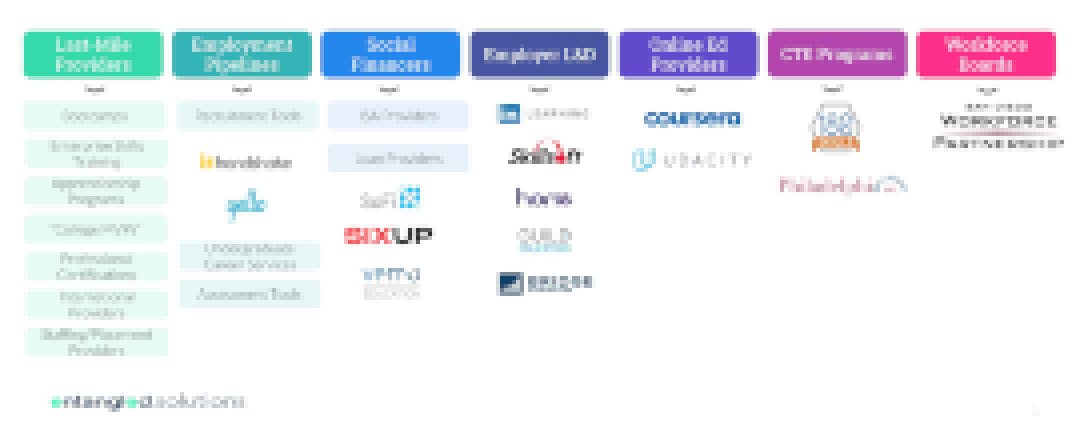General Assembly, a bootcamp, will help you master new skills in design, marketing, technology and data—and offer to help you get a job.
Udacity, an online-learning platform, helps you learn the latest in deep learning, machine learning, and web development—and promises it will help you qualify for your dream career.
At the end of a student’s journey, are bootcamps and online-learning platforms—just two examples of the recent explosion in new education providers that equip students with professional skills to be successful in jobs—that different from one another?
In his new book, “A New U: Faster + Cheaper Alternatives to College,” education investor Ryan Craig says yes. And he argues that the distinction matters.
Craig terms in-person bootcamps and other providers like apprenticeships and staffing and placement models “last-mile providers.” That last mile—the final connection between education and work—is, in Craig’s words: “technical training and placement,” defined as services that:
- connect students with employers;
- cater to employer demand for technical skills;
- offer clear job pathways;
- provide an intense learning environment;
- demonstrate competency development; and
- center around the job, not the credential.
Online providers, on the other hand, lack the intense learning environment and clear pathways into a job, Craig argues. He goes so far as to call “online bootcamps” an oxymoron.
Whether you agree with this characterization, companies like Coursera and Udacity have always seemed meaningfully different from Galvanize and General Assembly. The former group offers self-paced courses. You can take them for free or pay for a certificate. They are relatively low cost. And they are always online.
Despite their differences, General Assembly, Udacity, and a host of new education entrants all contribute to people’s career growth, regardless of which “mile” marker they may find themselves. That led us to ask and pursue, along with Harvard Business Publishing, the question: Is there a more comprehensive way to frame all the education providers focused on supporting learners early in their careers?
As we analyzed Craig’s work in the context of the broader higher education and workforce landscape, we reached the conclusion that “last-mile providers” are just one category within a larger segment of service providers that help learners both secure an early job and advance in their career. We call this broader segment “Early Career Enhancers.”
They come in many shapes and sizes. Some Early Career Enhancers directly support learners in learning new things. Others help employers upskill their workers. Some are hardly new, with established histories of working in higher education and workforce training. Our early efforts at mapping the Early Career Enhancers segment includes employment pipelines, social financers, employer learning and development (L&D) providers, workforce-aligned online education providers, career and technical education (CTE) programs, and workforce development boards.

As our taxonomy indicates, we agree with Craig. Online providers are not the same as last-mile providers, a category that includes bootcamps, college “Minimum Viable Products” that would last for roughly a year and result in a job, apprenticeship programs, staffing and placement providers, enterprise-skills training platforms, international skills training programs, and relevant industry certifications like the Project Management Professional certification.
But online providers do offer an important service. They may not help a young person launch her career. But for someone who is already established in one, they can be critical in helping that person upskill and stay current given the changing nature of technology. Each of the categories in our taxonomy, in other words, plays an important role in the workforce-education ecosystem, as they support early-career professionals by helping them prepare, find, or advance within their early jobs—or pivot in their careers.
That map is also likely to continue to evolve. Markets are dynamic, which means that our taxonomy—as imperfect as it may be now—will be more so in the future. In efforts to grab bigger market share, companies will change. It may be challenging for online learning providers to move into the last-mile space, given the asynchronous nature of their platforms and their emphasis on self-paced learning. But it may be possible for last-mile providers to move into the online space. Providers like General Assembly already offer an assortment of online courses, but they appear structured to mirror their in-person bootcamp offerings.
No conversation around education is complete without taking costs into the equation. The emergence of new funding models where financers align incentives around student success creates another opportunity for more dynamism. Income-share agreements (ISAs), in which students pay a percentage of their income after graduating instead of paying upfront, are becoming increasingly common. This financing model incentivizes the provider, investors, and servicers of these agreements to ensure that its students find lucrative employment opportunities after graduation.
In the years ahead, that alignment of interests could cause these ISA players to create a whole new set of services that blur the lines with our current category of employment pipelines. Today, most traditional undergraduate career services are under-resourced and ineffective, but that could turn around given the financial stakes tied to making sure students with ISAs get good jobs.
As Craig has written, last-mile providers have emerged to reduce the friction between education and work. And this broader ecosystem of programs and services is likely to continue to grow in importance in the years ahead because of a widening skills gap in the economy.
Understanding the current categories and the different players’ roles should allow us to better understand how the system can evolve—and where there may be holes for other entrepreneurs and existing institutions to continue to innovate to change our map—and the fortunes of learners.


